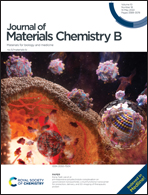A near-infrared light-driven photoelectrochemical aptasensing platform for adenosine triphosphate detection based on Yb-doped Bi2S3 nanorods†
Abstract
Due to its capability of low spectral interference, high light stability, and minimal photodamage to biological species, near-infrared (NIR) light is advantageous in biosensing and biochemical analysis. This work developed a photoelectrochemical (PEC) aptasensor for adenosine triphosphate (ATP) detection using NIR light as the irradiation source. In order to utilize NIR light, we prepared Yb-doped Bi2S3 (Yb-Bi2S3) nanorods to act as photoelectric transducing materials. Due to the unfilled 4f orbitals of Yb which introduced the impurity level between the valence band and conduction band of Bi2S3, Yb-Bi2S3 exhibited admirable photo-to-current conversion efficiency under NIR light irradiation. The Yb-Bi2S3 modified electrode was employed to construct a NIR light-driven PEC sensor using an ATP-binding aptamer as the recognition element. When ATP was present, the photocurrent signal of the proposed aptasensor declined, owing to the formation of an ATP–aptamer complex which enhanced the steric hindrance of electron transfer on the electrode. Under optimal conditions, the sensor showed a sensitive response to ATP in the concentration range from 0.5 to 300 nmol L−1 with a detection limit of 0.1 nmol L−1. The proposed aptasensor exhibited high selectivity, good repeatability and desirable stability. Moreover, it was successfully applied to ATP detection in human serum samples.



 Please wait while we load your content...
Please wait while we load your content...